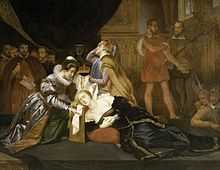Jane Kennedy (courtier)

Jane, Janet, or Jean Kennedy (died 1589) was a companion of Mary, Queen of Scots, during her captivity in England.
Jane was perhaps a daughter of Gilbert Kennedy, 3rd Earl of Cassilis. After the battle of Carberry Hill, Jane is said to have waited on Mary at Lochleven Castle where Mary was confined and signed abdication papers. Varying accounts mention her jumping from a wall while practicing for the Queen's escape, or leaping from a window to join the Queen as she fled the island, and helping row the boat to Kinross.[1]
In England, Jane was listed as a "maid" in Queen Mary's household at Tutbury Castle in October 1569, her name recorded by a French scribe as "Gin Cannate."[2] At Sheffield Castle, in 1571, she was listed as a "maid of the chamber."[3] In 1586, at Chartley Manor, Jane, described a Gentlewoman of the Queen's chamber, was responsible for Mary's jewels. An inventory of the jewels and silver in Jane's keeping was made when Mary was taken to Tixall for a fortnight and her possessions searched. Jane was also in charge of linen and laundry. At Fotheringhay Castle, Jane Kennedy and Elizabeth Curle helped Mary onto the scaffold and Jane tied her blindfold.[4] Jane and Elizabeth had been chosen for this duty by Mary herself.[5] The two ladies are featured and named in the Blairs Memorial Portrait of Mary Queen of Scots; Jane holds a white cloth. Another version of the picture is in the Royal Collection.[6]
After Mary

At the funeral of Queen Mary at Peterborough Cathedral on 1 August 1587, her ladies joined the procession in this order; Barbara Moubray, Christine Hog (the wife of Bastian Pagez), Renée du Raullay, Marie Pagez, Jane Kennedy, and Susan Kirkcaldy.[7]
Jane returned to Scotland and married Andrew Melville of Garvock, who had been the master of Mary's household. Andrew was a brother of the diplomats James Melville of Halhill and Robert Melville of Murdocairney. Andrew and Jane had been placed in joint custody of Mary's remaining jewels and silver plate.[8] Mary had required Andrew to take some of her belongings back to Scotland and her son King James VI after her execution, including portraits of her ancestors and a piece of a unicorn horn.[9]
Jane was drowned on the 7 or 8 September 1589 crossing the river Forth between Burntisland, where the Melvilles held Rossend Castle, and Leith. The ferry boat was "midway under sail, and the tempest growing great carried the boat with such force upon a a ship which was under sail as the boat sank presently."[10] Jane had been summoned by James VI to await the arrival of Anne of Denmark, who was expected to arrive at Leith. The loss of the ferry boat in stormy weather with all but two of the passengers was blamed on witchcraft.[11] In the following year people from North Berwick were made to confess to raising the storms and incriminate Francis Stewart, Earl of Bothwell.
In 1591 Andrew Melville was on hand to protect the King at Holyroodhouse when he was surprised by Francis, Earl of Bothwell. Andrew, who lived on the north side of Holyrood close, armed himself and entered the palace through the Abbey using a secret passage.[12] Andrew Melville continued to correspond with Bess of Hardwick, who had been Mary's keeper. In 1605 and 1607 he passed letters to the Countess, and in November 1608 sent news of an earthquake felt at Garvock.[13]
In fiction
In Friedrich Schiller's play Maria Stuart, Jane, as "Hanna Kennedy" is portrayed as Mary's nurse, and Andrew is "Melvil."[14]
References
- ↑ Stories of Kennedy's role at Lochleven were publicized by Nicolas Caussin, La Cour Sainte, (1664)
- ↑ Calendar State Papers Scotland, vol. 2 (1900), p. 696
- ↑ Calendar State Papers Scotland, vol. 3 (1903), pp. 565, 691
- ↑ Labanoff, A., ed., Lettres de Marie Stuart, vol. 7 (1842), pp. 242-249, 265: Morris, John, ed., Letter Book of Amias Paulet, (1874) p. 298, 367
- ↑ Calendar State Papers Scotland, vol. 9, (1915), p.272-3
- ↑ R. K. Marshall, Mary Queen of Scots, (NMS 2013), pp. 2-3
- ↑ La Morte de la Royne D'Escosse, (1589), quoted in Memoirs of John Napier, (1834), p. 144, (names standardized here): Calendar State Papers Scotland, vol. 9, (1915), p. 462, these six ladies are described as "eight Scottish women" who were penultimate in the funeral procession, followed by 166 black clad yeoman.
- ↑ Letter Book of Amias Paulet(1874), p. 367, Amias Paulet to Francis Walsingham: Calendar State Papers Scotland, vol. 9, (1915), p. 304
- ↑ Labanoff, A., ed., Lettres de Marie Stuart, vol. 7 (1842), p.254
- ↑ Calendar State Papers Scotland, vol. 10 (1936), p. 165-6, letters of William Ashby to Walsingham and William Cecil.
- ↑ Thomson, Thomas, ed., Memoirs of his own life by James Melville, (1827), pp. 369-70
- ↑ Thomson, Thomas, ed., Memoirs of his own life by James Melville, (1827), pp. 398-9
- ↑ G. R. Batho, Calendar of Talbot Papers, (HMC, HMSO, 1971), pp. 334-5
- ↑ Strickland, Agnes, Lives of the Queens Scotland, vol.7, (1858) pp. 507-8